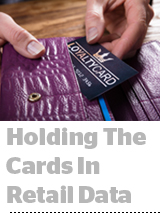 The 40-year-old company IRI, known for providing market share data to CPGs, has worked its way into marketer tech stacks, where its data is used for both targeting and attribution.
The 40-year-old company IRI, known for providing market share data to CPGs, has worked its way into marketer tech stacks, where its data is used for both targeting and attribution.
The bulk of IRI’s revenue still comes from its longstanding market share analytics business, said President and CEO Andrew Appel. “But business is shifting dramatically from store-based data and insights to people-based data,” he said.
Data companies like Nielsen Catalina Solutions and Dunnhumby, as well as linkage services like LiveRamp and Experian, have built up advertising revenue streams by connecting in-store transactions to digital activity. And IRI, which gets its data from retail loyalty programs, is securing its position in the lucrative new transaction data category.
The brand buy-in
IRI’s opportunity comes as brands like Hershey’s and Conagra that still sell primarily in stores want to quantify their online advertising.
Conagra worked with IRI for years on market share analytics, but “forged a more direct relationship” in 2015 when the food company went through a data-driven business transformation, said Christy Kazlo, the CPG brand’s former marketing science director, who was recently hired as VP of digital paid media at the consumer finance company Synchrony.
Conagra sought to build better audience profiles to engage customers and personalize marketing, she said.
Hershey’s began using IRI as its “source of truth” for sales data in 2017, said Vincent Rinaldi, Hershey’s head of addressable media and technology. He added that Hershey’s uses both The Trade Desk and Amobee DSPs in large part because they could plug into IRI data.
Neither company uses IRI to serve ads, but instead use IRI’s retail data to confirm in-store transactions. And that data is leading traditional brands into new media channels.
Hershey’s, for instance, uses IRI data to create nine-day look-back windows for online ad campaigns to drive in-store sales – a capability built into its DSPs. That window is a lot faster than the media mix models that took up to half a year to get enough sales lift data for offline attribution.
Faster data feedback means Hershey’s can quickly test new channels like CTV or streaming audio and add them to the mix if there’s incremental improvement.
AdExchanger Daily
Get our editors’ roundup delivered to your inbox every weekday.
Daily Roundup
It takes two to retail
Conagra and Hershey’s can only get those insights as long as IRI has addressable, up-to-date retail data. So IRI also needs stronger ties with those retailers to support its new initiatives.
Previously IRI would aggregate data from retailers, and now it’s using first-party retail data. IRI does not have a presence in Europe, but the change in its business model would be more apparent there since it would require data processor rights to use first-party data instead of its historical third-party data set.
Sam’s Club recently launched a DMP powered by IRI’s ad platform service, so in-store brands can target online ads or attribute sales using the retailer’s loyalty data.
Sam’s Club previously used homegrown advertising technology, but integrated IRI as its platform tech provider last year as it reinvests in its data-driven media business, said Abishake Subramanian, head of digital advertising and media sales.
Having an intermediary like IRI ensures Sam’s Club isn’t “grading its own homework,” he said. And instead of going to brands one by one to sell its ad offering, Sam’s Club can piggyback on IRI’s existing CPG relationships.
“What IRI has done is help us expedite the conversations with [CPG] leadership,” Subramanian said.
Do you believe the sale?
IRI also helps retailers bridge marketers who are dubious about the connection between an online ad viewer and an in-store shopper.
Hershey’s selected IRI as its sales data provider because its store transactions connect to deterministic profiles in an online consumer identity graph, as opposed to other solutions that measure the number of transactions in a store but don’t track individual shoppers, Rinaldi said. This means Hershey’s can brings store sales into the realm of multitouch attribution and performance marketing, he said, instead of waiting months for media mix models to measure campaigns.
In the old days, CPG brands knew exactly how many coupons were redeemed from a coupon circular or if product was moving faster off the shelf. The connection from coupon distribution to coupon redemption was direct, so it was an easy sell for brands.
It’s more difficult for digital ad platforms to prove themselves, because it requires marketers to make a mental jump from online to offline, Appel said.
Retail ad platforms face a higher bar for attribution because the conversions are offline, Appel said. “In many ways (retailers) provide better measurement than the last-click links that drive online DR, but they face an inherent skepticism.”












